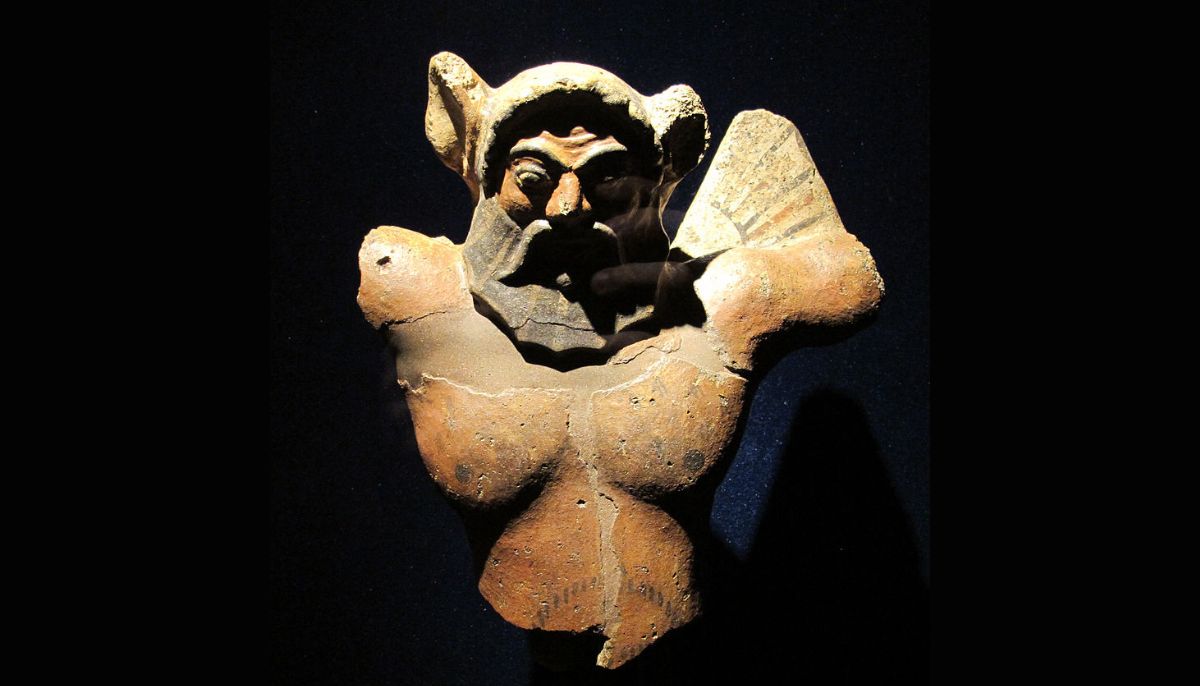With multiple heads and serpent-like features, Typhon embodies the untamed forces of nature that even the mightiest deities must confront.
This article delves into the captivating story of Typhon, exploring his role in the Typhonomachy and his larger significance in the succession myth.
Join us on a journey through the depths of Greek mythology as we unravel the enigmatic tale of Typhon.
Birth of Typhon
Typhon, also known as Typhoeus, was a monstrous storm giant of ancient Greek mythology. Born of the union between Gaia (Earth) and Tartarus (the Pit), he emerged as a colossal force, seeking dominion over gods and mortals.
Typhon’s parentage was traced to Gaia and Tartarus, embodying the primal elements of Earth and the Abyss. In alternative accounts, he was described as the offspring of Hera, a testament to the complex genealogy of Greek myths.
Family of Typhon
His progeny were a host of legendary monsters, each bearing a fearsome reputation in their own right.
Notable among his offspring were the likes of Orthus, Cerberus, the Hydra, and the Chimera.
These creatures would become enduring figures in Greek mythology, known for their monstrous attributes and formidable abilities.
What did Typhon look like?
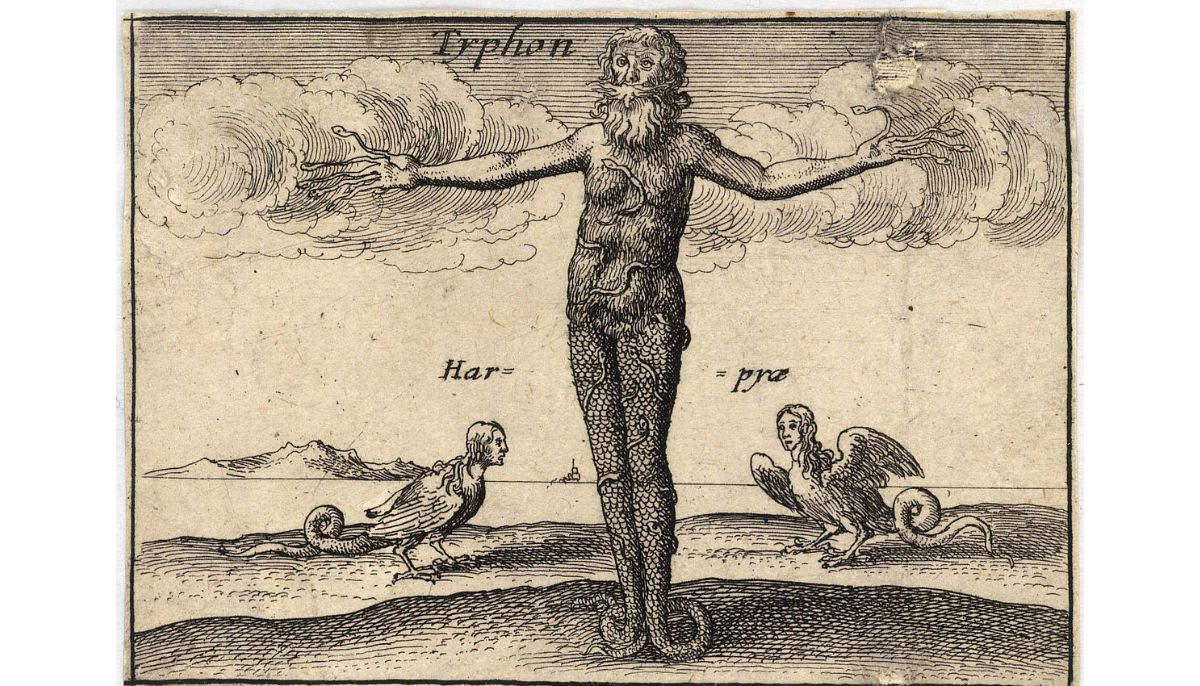
Described in various classical sources, Typhon was a colossal figure. His immense stature was said to reach the very stars, and he was often depicted as a winged giant. His lower half consisted of coiled serpents instead of legs, and his upper body resembled a man’s, albeit with some grotesque features.
Typhon’s appearance was truly fearsome. He had a filthy, tangled beard, pointed ears, and eyes that blazed with fire. His hands were not as expected; instead, he possessed a hundred serpent-headed fingers, which he could employ with devastating effect. His fingers numbered two hundred in some accounts, each ending in a serpent head, making him an even more formidable adversary.
As a volcano-giant, Typhon was associated with the powerful forces of nature. He could unleash red-hot rocks towards the heavens, and his very breath spewed fire and molten fury.
Typhon Mythology
The clash between Typhon and Zeus was an epic struggle of unparalleled proportions.
Armed with his mighty thunderbolt and bolstered by the power of the gods, Zeus descended from Mount Olympus to confront the monstrous Typhon.
The earth quaked, the seas roared, and the sky blazed with lightning as the two titans clashed in a cataclysmic battle.
Typhon’s battle with Zeus
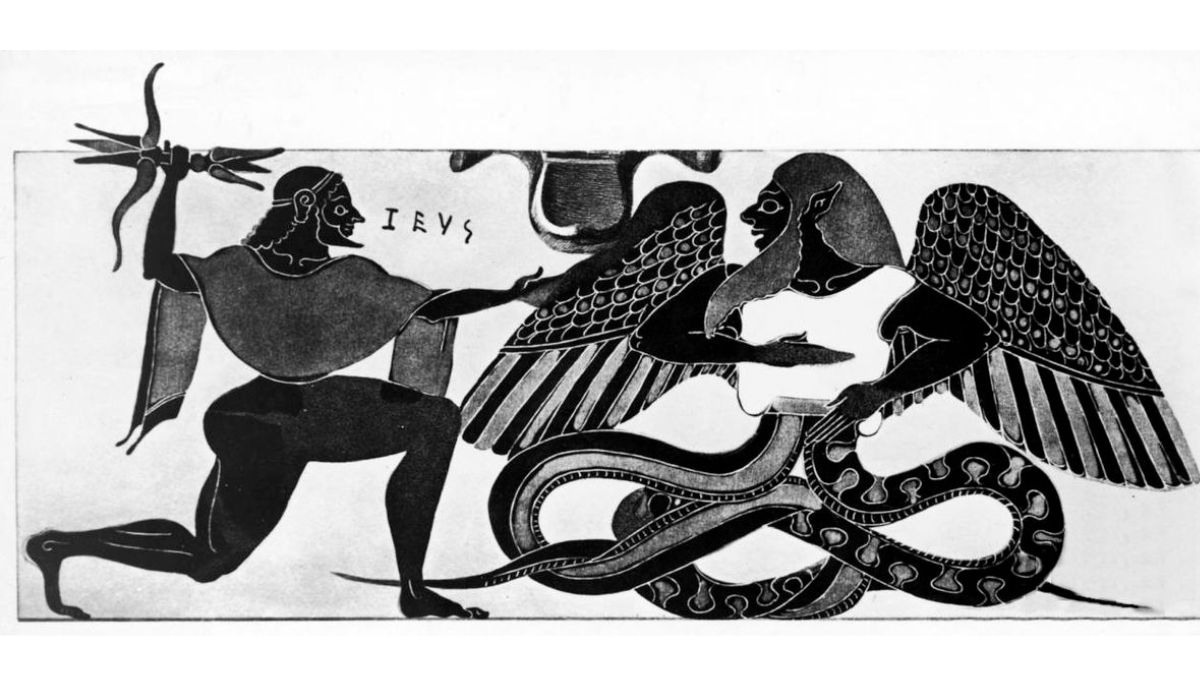
With relentless fury, Typhon unleashed his formidable powers. His hundred serpent-headed arms lashed out, spewing fire and chaos. Each of his serpent heads hissed and spat venom, creating an onslaught of nightmarish sounds that echoed through the heavens. The very foundations of the earth trembled under the force of their titanic struggle.
In response, Zeus, the king of the gods, wielded his thunderbolt with unparalleled skill and precision. The sky rumbled with thunder, and lightning bolts tore through the tumultuous air. With each strike, Zeus sought to subdue the monstrous force that threatened the balance of the cosmos.
The battle raged, with Typhon’s immense size and strength pitted against Zeus’ divine mastery over the elements. Fire clashed with lightning, the earth shook beneath their colossal footsteps, and the fabric of reality seemed to quiver under the weight of their conflict.
In a climactic moment of divine intervention, Zeus summoned the full extent of his godly power. With a thunderous roar and a blinding flash of light, he struck Typhon, sending the monstrous giant crashing to the earth. The force of Zeus’ blow was so immense that it melted the mountains, leaving behind a scarred and smoldering landscape.
Where was Typhon Buried?
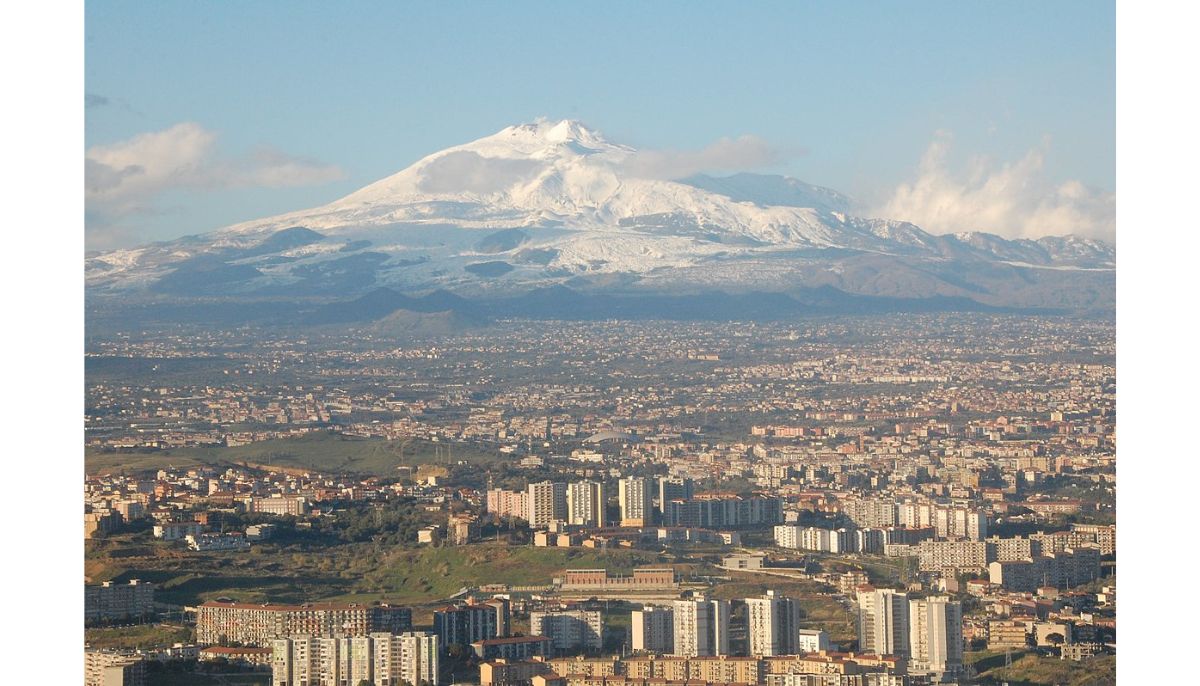
Typhon met his final fate in two distinct but intertwined locations of ancient significance.
One, Tartarus, the abyssal pit of the underworld, became the stormy prison for the defeated monster.
The other, Mount Etna, or Aitna in antiquity, rose as a colossal sentinel, bearing witness to Typhon’s torment for all eternity.
This section delves into the narratives surrounding Typhon’s imprisonments, chronicled by various ancient sources. These accounts not only elucidate the depths of ancient myth-making but also offer a glimpse into how mythology intertwined with the natural world.
Typhon and Tartarus
In the epic Theogony, Hesiod recounts the battle between Zeus and Typhon. After a fierce struggle, Zeus emerged victorious.
He then cast Typhon into Tartarus, a vast and dreadful pit within the depths of the underworld. This became Typhon’s eternal prison. From there, he was believed to unleash powerful, wet winds, except for the gentle Zephyros, Boreas, and Notos.
Source: Pindar’s Pythian Ode 1
Pindar’s Pythian Ode corroborates this account, portraying Typhon as a formidable adversary vanquished by Zeus.
He was subsequently banished to the depths of Tartarus, where Typhon’s wrath manifested through various tempestuous winds, influencing the natural world.
Typhon and Mt Etna
According to multiple ancient sources, including Aeschylus, Ovid, and Strabo, Mount Etna, known as Aitna in antiquity, played a central role in the imprisonment of Typhon.
The legends describe Typhon as a hundred-headed monster, subdued by Zeus with a powerful thunderbolt. His sprawling form was then bound beneath the towering heights of Mount Etna.
Here, Typhon’s back is said to be scarred and torn by the rugged terrain, portraying the magnitude of his agony. With its snowy summit and spewing torrents of molten fire, the mountain became a visual emblem of Typhon’s inescapable captivity.
This enduring myth explained Mount Etna’s volcanic activity and provided an awe-inspiring narrative for the ancients.
Typhon, Zeus, and the Succession Myth of Greek Mythology
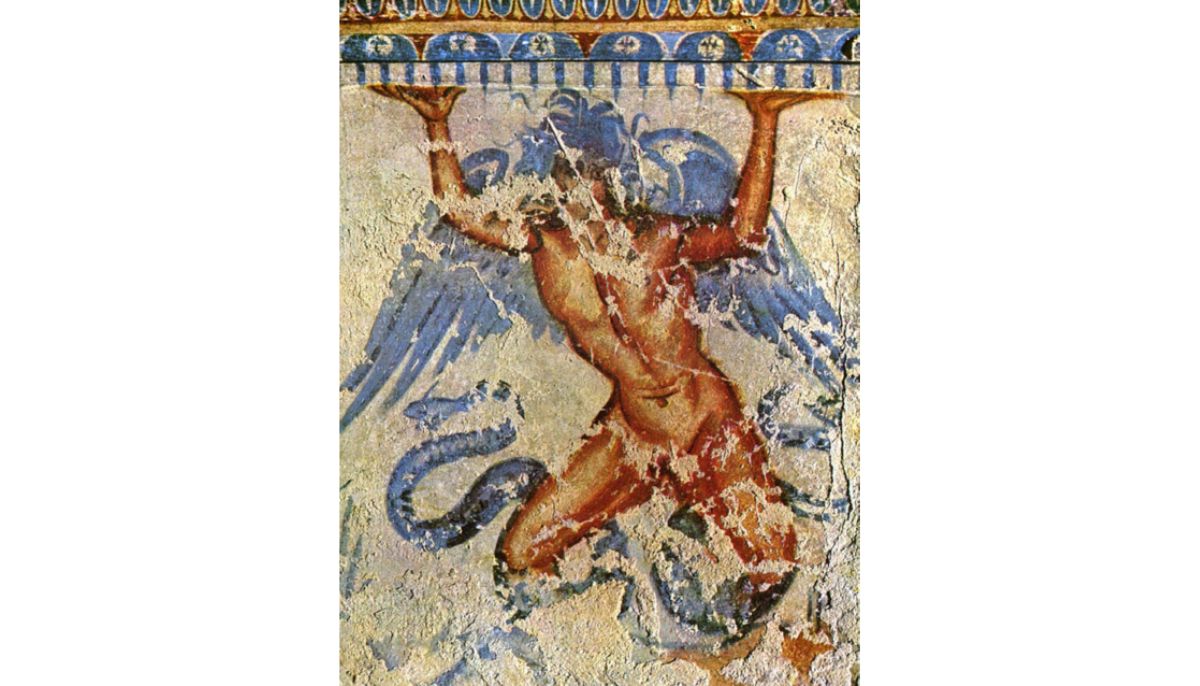
The Succession Myth, a central tale in Greek mythology, recounts how power shifted among the ancient forces. It all began with Uranus, the first ruler of the universe, who hid his children within Gaia, the Earth. But Uranus was overthrown by his son Cronus, who, in a bold move, defeated and castrated his father. However, this led to a pattern of power struggles.
Fear of his own downfall, Cronus swallowed his newborn children, attempting to prevent potential threats. Yet, this triggered a fateful clash with destiny. When Zeus was born, his mother Rhea substituted him with a carefully wrapped stone. Raised secretly, Zeus became a powerful force ready to challenge the existing order.
In the epic Typhonomachy, Zeus faced Typhon, a fearsome and unparalleled adversary. This climactic battle ended in Zeus’ triumph, securing his status as the ultimate ruler. With his newfound power, Zeus organized the gods, assigning them specific roles and tasks to maintain cosmic harmony. He also strengthened his reign through strategic marriages and alliances.
Despite his ascendancy, a prophecy warned Zeus of a son from his first wife, Metis, who would surpass him in strength. Zeus took a drastic step to avert this potential threat and break the succession cycle: he swallowed Metis.
This ensured his unchallenged rule and marked a crucial turning point in the Succession Myth, illustrating the profound impact of divine intervention and strategic maneuvering in ancient Greek cosmology.
Symbolism and Legacy of Typhon
Typhon, the formidable adversary of Zeus, holds a significant place in Greek mythology, embodying primal chaos and the untamed forces of nature. As a multi-headed monster with serpent-like features, Typhon symbolizes the raw, uncontrollable power that even the mightiest gods must confront.
Depictions of Typhon in ancient Greek art often emphasized his monstrous and awe-inspiring nature. His portrayal served as a reminder of the ever-present chaos that even the gods must contend with. Over time, Typhon’s legacy evolved over time, becoming a symbol of the primordial forces underlying the ordered cosmos.
His role in the Typhonomachy highlights the eternal struggle between order and chaos, reminding us of the unyielding forces that shape our world. Typhon inspires and captivates through his legacy, leaving an indelible mark on the tapestry of myth and human imagination.
Want to know more about the creatures and monsters of Greek Mythology?

Explore more articles like this in our broader series on Greek monsters. To delve even deeper into the world of mythical creatures, be sure to check out our comprehensive hub article on the monsters of Greek mythology.
